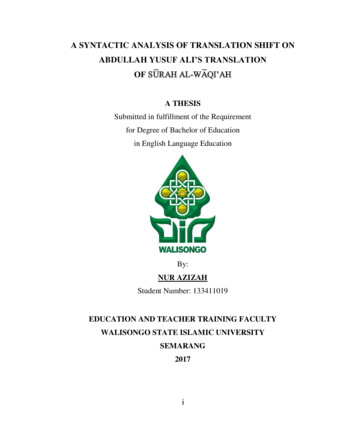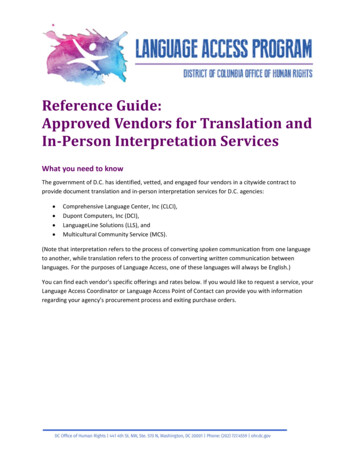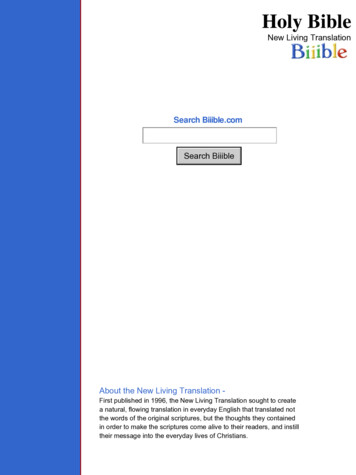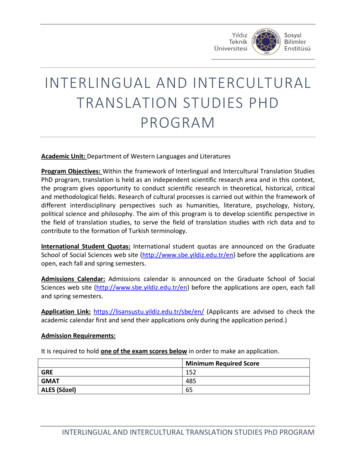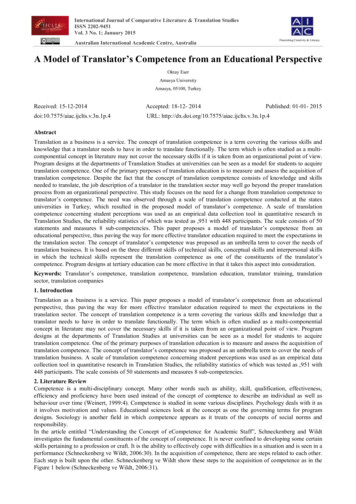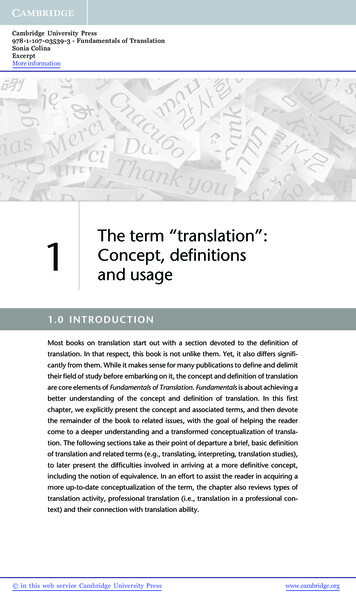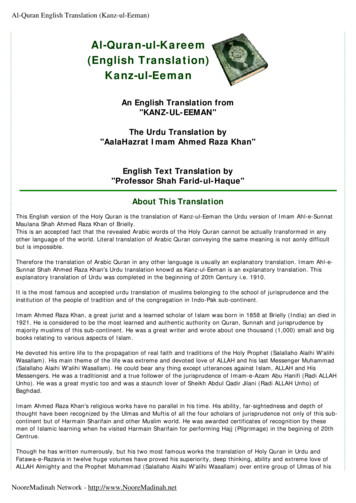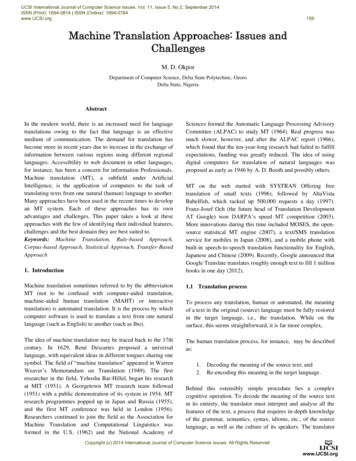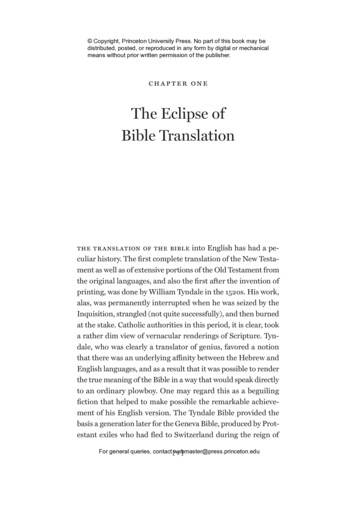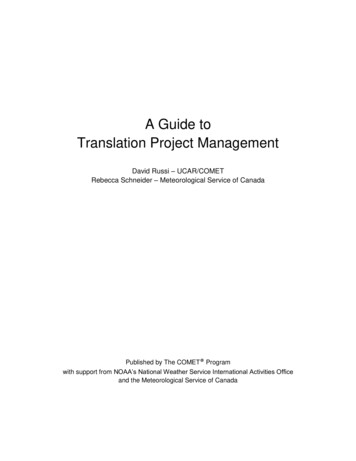
Transcription
A Guide toTranslation Project ManagementDavid Russi – UCAR/COMETRebecca Schneider – Meteorological Service of CanadaPublished by The COMET Programwith support from NOAA’s National Weather Service International Activities Officeand the Meteorological Service of Canada
Version 1.0 Copyright 2016 The COMET ProgramAll Rights ReservedLegal Notice: https://www.meted.ucar.edu/about legal es.php
PrefaceThis Guide to Translation Project Management provides a set of written guidelines meant toassist organizations around the world wishing to produce quality translations. Although it wasdesigned primarily as a resource for National Meteorological and Hydrological Services(NMHSs) interested in translating instructional materials to support their training andprofessional development efforts, the general concepts are relevant to any agency ororganization desiring to distribute information in other languages.Translation is a complex endeavor, requiring the active collaboration of multiple participants inorder to produce a quality product. This guide explains the process involved, describes somepossible pitfalls and ways to avoid them, and offers guidance in creating a translation team,including the selection of a translation company or independent translators. It also touches onaspects such as translation and distribution formats, rates, tools, resources, and best practicesthat can contribute to a good outcome. Finally, the guide includes sample checklists, guidelinesand instruction sheets that can be customized for use in various stages of the translationprocess.This guide was developed as a collaboration project by The COMET Program and theMeteorological Service of Canada (MSC). Many thanks to Corinne McKay for her manyexcellent suggestions, and to Bruce Muller, for editing.A Guide to Translation Project Managementi
Table of ContentsTable of Contents . ii1.0.0 Defining Translation . 11.1.0 Why Do We Translate? . 11.2.0 Defining Translation . 11.3.0 Who Can Benefit from Translation? . 21.4.0 Understanding the Translation Process . 21.5.0 Summary . 32.0.0 Planning a Translation Project. 42.1.0 Identify a Project Lead or Team. 42.2.0 Define the Scope of the Project . 42.2.1 What Really Needs to Be Translated? . 42.2.2 Source Materials . 52.2.3 Format types and considerations . 52.2.4 Audio . 72.2.5 Graphics and Animations. 72.2.6 Delivery Format . 82.2.7 Translation Technologies. 82.3.0 Budget and Rates. 92.4.0 Copyrights .112.5.0 Summary .113.0.0 Assembling a Translation Team .123.1.0 In-House Talent .123.2.0 Translation Companies.123.3.0 Freelance Translators .133.4.0 Subject Matter Experts .153.5.0 Summary .154.0.0 Supporting the Translation Process.164.1.0 Communication .164.2.0 Project Documentation .174.2.1 General Translation Guidelines .174.2.2 Specific Role Guidelines .174.2.3 Project Plan .184.2.4 Project Instructions .184.2.5 Checklists .18A Guide to Translation Project Managementii
4.2.6 Reference Materials .184.2.7 Language Style Guides .194.2.8 Glossaries .194.3.0 Summary .205.0.0 Supporting Documents .21Translation Project Tracking SheetTranslation Instructions TemplateTranslation Q&A TemplateGuidelines for TranslatorsGuidelines for EditorsGuidelines for ProofreadersGuidelines for Subject Matter Experts (SMEs)Checklist for TranslatorsChecklist for EditorsChecklist for ProofreadersChecklist for Subject Matter Experts (SMEs)A Guide to Translation Project Managementiii
1.0.0 Defining Translation1.1.0 Why Do We Translate?Transferring information —scientific, philosophical, literary, commercial, political, artistic—across linguistic barriers is an important and necessary component of the human endeavor.For information providers, translation expands the number of people who can access theinformation, allowing it to reach an audience that would otherwise not benefit from it.Today, translation is more widespread and accessible than ever before. Translation efforts canbe organized in creative ways: organizations with larger budgets may choose to hire atranslation company or independent professional translators to handle all of their translationneeds; organizations with smaller budgets, or with subject matter that is not familiar to manytranslators, may decide to combine the services of professional translators with the skills ofexisting staff members; finally, organizations with a pool of expert volunteers may opt to includetheir services in the process. Whatever your budget and translation needs, there are ways tomake it work.1.2.0 Defining TranslationTranslation is an activity, a product, and a process. As an activity, translation is a complex actthat requires close reading of a text in the source language, understanding its meaning, andcreating an equivalent text in the target language. The word “translation” also refers to theproduct of this activity: the final target language text that will be published or distributed.Although this document will touch on these aspects of translating, we will focus primarily on theprocess of creating a translation, using this definition:Translation is the process of conveying a written source language text clearly,completely, accurately, and appropriately in a target language.The term process refers to the steps or stages that a translator and/or a group of translatorsfollow to produce a quality translation. Our definition also describes some particular qualities atranslation should possess in order to be “good”. In other words, it should be: Well-written: Proper grammar and spelling, appropriate use of terminology, and clearexpression of concepts are common to all good writing.Accurate: Various factors can lead to inaccuracy in a translation, such as incorrectinterpretation of the source text, inappropriate or incorrect terminology choices, andomission or addition of key concepts in the target text.Complete: Missing concepts, missing sentences, missing words, missing symbols allcontribute to a translation not being complete.Appropriate: The translation should be appropriate for the audience that will use it, andfor the context in which it will be used, taking into consideration cultural aspects.Note that the following do not constitute translation, though they may be part of the process: A simple substitution of words from one language to another: Translation is a complexact that requires close reading of the source text in order to understand its meaning andrender it appropriately into the target language.A Guide to Translation Project ManagementPage 1
Automatic/machine translation: Machine translation is a tool that can be used in thetranslation process, but it cannot, at least with current technology, produce a translationthat meets the criteria for accuracy and appropriateness that we would expect of aprofessionally translated text.Summarizing or paraphrasing: While these activities can be useful ways to conveyinformation across languages, they are not, strictly speaking, translation.Interpreting: Although related, translation is different and should be distinguished frominterpreting, which involves conveying the spoken word from one language to another.As a translation buyer, you will also look at translation as a product, or as a professional service,and thus you will have certain expectations as to its quality. However, it differs from most otherproducts and services in one fundamental respect: without knowing both the source and targetlanguages, you cannot fully evaluate the quality of a translation. A translation can be accurate,but poorly written in the target language. A translation can be beautifully written, while failing toaccurately convey the meaning of the source text. By being directly involved in the translationprocess and with the people who participate in it, you will be able to understand and trust thefinal product to a greater degree. As an educated consumer, you may avoid unpleasantsurprises later.1.3.0 Who Can Benefit from Translation?Almost any organization can benefit from translation. People learn better and retain informationmore effectively in their own language, and providing materials in the reader's native tongue willprobably result in greater understanding and better learning outcomes. Translation can helporganizations that work in languages that are not widely spoken around the world, that serve apublic that speaks a second language, or that do not have the financial resources to developtheir own materials to meet their training needs.Translation can be a very cost-effective investment, when it is done well. Often, the cost ofdeveloping effective training on any topic in your own language will be far greater than the costof producing a high-quality translation of an existing foreign language lesson.This Guide to Translation Project Management is designed to increase your understandingof the translation process, to assist you in managing a project to develop training materialsthrough translation, and to help you avoid some possible pitfalls. While it specifically aims tohelp National Meteorological and Hydrological Services (NMHSs) use translation to meet theirworkforce training needs, the general concepts presented can be useful to any agency ororganization needing to make information available in other languages.1.4.0 Understanding the Translation ProcessWhile a single person can translate a text for informational purposes, it generally takes multipleparticipants to produce a quality, final translation for publication or distribution. Translation isalso a multi-step process, involving some iteration and redundancy. We can break this processdown into a series of general steps:1. Translation: The first phase of the translation process involves creating the initial targetlanguage text. It generally works best to have a single translator or a small, collaborativeteam of translators translate all the material. Most (although not all) professional translatorsA Guide to Translation Project ManagementPage 2
work into their native language only. A translator who is also an expert in the field is ideal,but may not always be easy to find. In these cases, review by an expert in the field isstrongly recommended as part of the Editing/Revising step. The translation stage canrequire a lot of research. It is also the time when a bilingual glossary may be created,problems are identified, and content questions are addressed.2. Editing/Revising: Editing involves checking the translation thoroughly against the original inorder to eliminate any possible errors, ambiguities, and omissions. All changes interminology need to be made consistently throughout the text, and in the project glossary.This step is often performed by a translator who works in the same language pair as theoriginal translator. However, it may be beneficial to have the text checked by a nativespeaker of the source language, who may be able to spot errors due to the translator’smisinterpretation of the source text. If the original translator was not an expert in the field,use an expert target-language reviewer with good writing skills, even if he or she is not aprofessional translator.3. Proofreading: This final quality assurance step serves to smooth out the writing, correct anyminor punctuation and style details, and run a final spelling check. At this point, it should notbe necessary to consult the source text except for clarification. The proofreader should haveexcellent native command of the target language and should be familiar with the styleguidelines being used for the document.4. Maintenance: While not an inherent part of the process of translation, this step is important toavoid the material becoming obsolete. Updates to the original material should trigger the updateof any translated versions. Simple updates may be handled by one translator, but more complexupdates with extensive changes or rewriting may call for editing/revising, and proofreading.It is worth noting that professional translators typically perform the first three steps themselvesbefore presenting their work to the editor or reviewer, who will likely repeat steps 2 and 3.Related LinksTranslation: Getting it Right. A guide to buying ing it right.pdfCOMET's Translation resource Center:https://www.meted.ucar.edu/training module.php?id 12931.5.0 SummaryTranslation is the process of conveying a written source language text clearly, completely,accurately, and appropriately in a target language. Translation allows information to betransferred across languages, expanding accessibility of the information. The translationprocess involves translation, editing, and proofreading. Training programs at NMHSs may beable to use translation as a cost-effective means to expand their training program's offerings.A Guide to Translation Project ManagementPage 3
2.0.0 Planning a Translation ProjectHere are some of the tasks that should be part of your translation project:1. Identify the person or persons who will oversee the translation effort.2. Define the scope of the project: identify the materials for translation and the language(s)involved, evaluate the source material contents and technical characteristics (file types,accessibility, format, etc.).3. Budgeting: Identify the financial resources available for your project.4. Consider copyright issues.5. Identify resources: a translation company, freelance translators, members of yourorganization, or a combination.6. Create a project plan.7. Establish a timeline.8. Execute and manage the project.9. Create a maintenance plan for the translated materials.We will consider the first four points in this section, and turn to the others in later sections.2.1.0 Identify a Project Lead or TeamTranslation management must be tailored to the size of the organization and its resources.Oversight may range from simple handoff to a translation company (sometimes known as alanguage service provider, or LSP), to complete involvement in selecting translators, editors andreviewers, and managing the entire project. Appointing appropriate staff skilled in organizingand managing complex processes will be essential for the development of a successful inhouse translation program.2.2.0 Define the Scope of the ProjectFrom the outset, it will be important to identify the specific needs your organization wishes toaddress through translation (for example, supporting aeronautical meteorologist training,meteorological observer training, or a continuing professional development program), and to setrealistic goals to meet these needs within your specific budget. One of the key aspects of thistask will be assessing the materials to be translated: to assure that they are best suited to meetyour current training needs, and that they also have a high chance of remaining relevant for along period of time.2.2.1 What Really Needs to Be Translated?Organizations must be efficient and smart in deciding which materials to translate. Dependingon your organization’s needs, not all materials may require full, precise translation. Carefulanalysis of the original can reveal parts that can be shortened or omitted from the translation,thus reducing the amount of work involved, and, ultimately, the cost of translation.For example, you may have permission to translate a lesson on a specific scientific concept thatalso contains text or graphics that are not needed for your purposes, such as the history of thegroup that developed the original document, or historical overviews that may not be relevant toyour audience. In these cases, you may decide to summarize, or perhaps to omit those sectionsentirely.A Guide to Translation Project ManagementPage 4
As pointed out earlier, summarizing is really not translation. However, a target languagesummary of a document (for example, the results of a study) can be useful to convey certainspecific information. If you choose to adopt this strategy, you should ensure that the person incharge of producing the summary is qualified to read the source text and summarize it in thetarget language.In some cases, a summary of a document, lesson, or other material may be useful to makecertain decisions. For example, when identifying documents as potential candidates for fulltranslation, you might want a brief description of the content in order to decide whether thematerial actually matches your needs. This strategy can help those involved in the selectionprocess make more informed decisions about what to translate and avoid the cost of translatingirrelevant material.2.2.2 Source MaterialsThe selection of source materials for translation requires careful consideration of variousaspects besides their relevance, such as quality, effectiveness, usability, and format. Evaluatingyour instructional needs will be an important part of the selection process. You will want toinvolve the people in charge of training in your organization in making this determination and inidentifying relevant materials that will convey the concepts you need to present effectively.Whenever possible, the linguistic quality of the materials should also be evaluated beforedeciding whether to translate them. A well-written document that presents concepts clearly andconcisely will be easier to translate than one that is written in a verbose, convoluted style. Apoorly written original may take longer to translate, and the final product may reflect the weakquality of the source text. If you have control of the original, reviewing the text for anyimprovement or simplification prior to translation may be a good option.If your organization develops its own materials, it might consider an approach to writing thatfacilitates and supports later translation or adaptation. Consistent use of terminology, clearwriting that avoids slang and cultural references, the use of examples from multiplegeographical locations, and consistent use of international units, are some approaches that canmake the source text easier to translate.2.2.3 Format types and considerationsWe can consider format in two different ways: Delivery format: This refers to how the material is presented to the end user. Forexample, a textbook, a web-based lesson, a presentation, or perhaps a webinar. All ofthese delivery formats will present their own challenges, and will have to be handled in aparticular way for translation.Translation format: How the content will be handled during the translation process. For awebinar, for example, the format might be a simple text file containing the transcription ofthe lesson. In the case of a web-based lesson, the format might be an HTML file.Formats vary widely. Most prepared instructional materials are initially developed as text andthen formatted for use or distribution, either in printed or electronic form. This is often true ofnarrated lessons that start out as scripts, although this is not always the case; in live lectures orwebinars, the presenter delivers the content orally, but without a set script.A Guide to Translation Project ManagementPage 5
By definition, translators work with text, the written word. The formats used in the translationprocess can also vary, most often as a function of the delivery format. The translator’scapabilities are also a factor: for example, all translators work with word processing files, butsome may not be able to work with HTML files.Access to source files is an important consideration. Distribution-friendly formats such as PDFsare difficult for translators to work with; the process will be much easier with the source filessuch as MS Word, Excel, etc. This is also true of the graphics that accompany the text:producing translated images will be much easier if the original source graphic files containingthe text layers are available. Obtaining the source files will help streamline the translationprocess.These are some general format considerations: Avoid formats that impose word or page length limits based on the source language text,such as windows or buttons that are sized to the original and don't allow for expansion.Text created in English often takes up less space than the equivalent text in anotherlanguage, such as German or Spanish.Choose materials that are available as text, or in a format that can be easily convertedwithout requiring specialized programs.Locate the source files, if necessary by requesting them from the organization thatdeveloped the original materials.Consider whether you have the resources available to extract text for translation fromprograms such as Adobe Flash, which are not translation-friendly, or to work withgraphics, or audio files.Consider the formats you and your translators can work with. Most translators today usetools that allow them to work in a wide range of formats, but not all have access tospecialized programs. For example, if you have HTML files, but your translator onlyworks in MS Word, you have to figure out how to convert HTML to MS Word format.Don’t assume that your translator or other participants will be able to work with fileformats other than MS Word: ask before the project begins.Consider whether any graphics or animations contain text. Graphics with captions,legends or explanations require special handling, the use of graphics software, andaccess to graphic source files.Consider the impact of narration or other audio. If the translated product will be narrated,these materials may require a considerable amount of processing and resources, whichwill increase the cost and time required to produce the final translated product. Forexample, you will need to either obtain the script for the source audio files, or have themtranscribed, then translated, and then re-recorded in the target language.Consider cloud-based software options. Many software vendors now offer relativelyinexpensive access to sophisticated cloud-based programs. Depending on your budget,for a fairly modest fee you may be able to provide translators access to specialized tools,and perhaps even some training on how to use them.A Guide to Translation Project ManagementPage 6
2.2.4 AudioLessons presented as recorded narrations and webinars can be appealing, but require muchmore processing to produce in translation.Recording the material in the target language will always involve additional work and resources,such as contracting voice talent, producing and processing audio tracks, and incorporating theminto the final delivery format of the lesson. Whether these activities are handled in-house orcontracted out, they can add up to significant costs.One cost-cutting option is to provide the transcript and, if possible, include Closed Captioning.Some cloud-based video hosting tools, such as YouTube, provide Closed Captioningfunctionality.2.2.5 Graphics and AnimationsMany training materials include illustrations, animations, and other graphic elements thatcontain embedded text. Commonly used image formats in lessons and presentations (such as.jpg, .png, and .gif files) do not contain editable text layers. Access to source files in a formatthat preserves the text layers and allows them to be edited with a graphics program, like AdobePhotoshop, will facilitate the process of creating target language versions of graphics. Whensource files are not available, in most cases it will still be possible to layer translated text on theimage, though the process will be more time consuming, and the quality of the final graphic maynot be optimal.Animations present additional challenges. As an animation unfolds, callouts or explanationsmay appear at different moments, or each frame may contain slight differences in text, as canoccur with animations of data products. Animations should be evaluated before translation toidentify any technical or text-related issues that may need to be addressed.Generally, unless the translator is willing and able to work directly in a graphic or animationformat —something that is not common in the industry— you will need to devise a strategy forhandling graphics. One possible approach consists of compiling a document with a screen shotof each visual and having the translator type below each graphic or animation every textelement it contains.The translator and the person actually producing the target language graphics will have to beparticularly vigilant to avoid introducing errors, especially when placing text on graphics oranimations.One way to reduce the time and costs involved in producing foreign language graphics oranimations is to leave them in the original language, and provide translations or explanations,either in the translated text or as explanatory captions below each item.Consider these aspects related to handling any graphics and animations included in thematerials you will translate: Do you have source files for the graphics and animations?Can your translators or translation company work in graphics programs, such asPhotoshop, or Flash? What costs will be involved?A Guide to Translation Project ManagementPage 7
Consider cloud-based software options. Many software vendors, such as Adobe andMicrosoft, now offer relatively inexpensive access to cloud-based programs. Dependingon your budget, for a fairly low fee you may be able to provide translators access tospecialized tools to work in graphics.How will you send graphics to be translated? How should the graphics text be returnedto you?Can you create target language versions of the images or animations in-house?Do you have permission to use and modify copyrighted graphics?Whenever possible, choose graphics with little or no overlaid text and keep anyexplanatory text separate.Choose graphics with text that obscures as little of the image as possible.Take the physical length of the text into account, a particular issue in graphics, wherespace is often limited. While reducing font size or vertical spacing can helpaccommodate longer text, be aware of possible readability issues.Avoid graphics that are culturally sensitive. Images can represent different things indifferent cultures. Even colors can have different meanings to different people. (Forexample red is considered unluc
A Guide to Translation Project Management i Preface This Guide to Translation Project Management provides a set of written guidelines meant to assist organizations around the world wishing to produce quality translations. Although it was designed primarily as a resou
